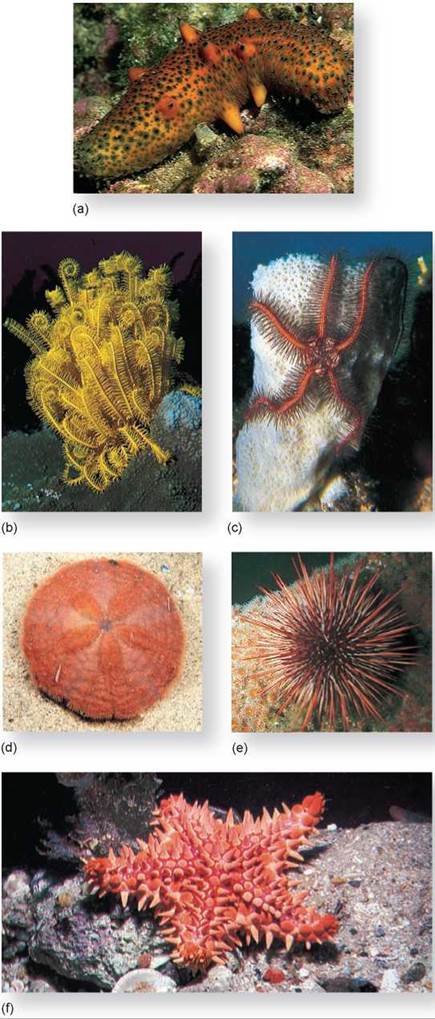THE LIVING WORLD
Unit Five. Evolution of Animal Life
19. Evolution of the Animal Phyla
19.12. Echinoderms: The First Deuterostomes
The first deuterostomes, marine animals called echinoderms in the phylum Echinodermata, appeared more than 650 million years ago. The term echinoderm means “spiny skin” and refers to an endoskeleton composed of hard, calcium- rich plates called ossicles that lie just beneath a delicate skin. When they are first formed, the plates are enclosed in living tissue, and so are truly an endoskeleton, although in adults they fuse, forming a hard shell. About 6,000 species of echi- noderms are living today, almost all of them on the ocean bottom (figure 19.27). Many of the most familiar animals seen along the seashore are echinoderms, including sea stars (starfish), sea urchins, sand dollars, and sea cucumbers.

Figure 19.27. Diversity in echinoderms.
(a) Warty sea cucumber, Parastichopus parvimensis. (b) Feather star (class Crinoidea) on the Great Barrier Reef in Australia. (c) Brittle star, Ophiothrix (class Ophiuroidea). (d) Sand dollar, Echinarachnius parma. (e) Giant red sea urchin, Strongylocentrotus franciscanus. (f) Sea star, Oreaster occidentals (class Asteroidea), in the Gulf of California, Mexico.
The body plan of echinoderms undergoes a fundamental shift during development: All echinoderms are bilaterally symmetrical as larvae but become radially symmetrical as adults. Many biologists believe that early echinoderms were sessile and evolved adult radial symmetry as an adaptation to the sessile existence. Bilateral symmetry is of adaptive value to an animal that travels through its environment, whereas radial symmetry is of value to an animal whose environment meets it on all sides. Adult echinoderms have a five-part body plan, easily seen in the five arms of a sea star. Its nervous system consists of a central ring of nerves from which five branches arise—while the animal is capable of complex response patterns, there is no centralization of function, no “brain.” Some echinoderms like feather stars have 10 or 15 arms, but always multiples of five.
A key evolutionary innovation of echinoderms is the development of a hydraulic system to aid movement. Called a water vascular system, this fluid-filled system is composed of a central ring canal from which five radial canals extend out into the arms (see the Phylum Facts illustration on the facing page). From each radial canal, tiny vessels extend through short side branches into thousands of tiny, hollow tube feet. At the base of each tube foot is a fluid-filled muscular sac that acts as a valve (the yellow balls labeled “ampulla”). When a sac contracts, its fluid is prevented from reentering the radial canal and instead is forced into the tube foot, thus extending it. When extended, the tube foot attaches itself to the ocean bottom, often aided by suckers. The sea star can then pull against these tube feet and so haul itself over the seafloor.
Most echinoderms reproduce sexually, but they have the ability to regenerate lost parts, which can lead to asexual reproduction. In a few sea stars, asexual reproduction takes place by splitting, and the broken parts of the sea star can sometimes regenerate whole animals.

Key Learning Outcome 19.12. Echinoderms are deuterostomes with an endoskeleton of hard plates, often fused together. Adults are radially symmetrical.